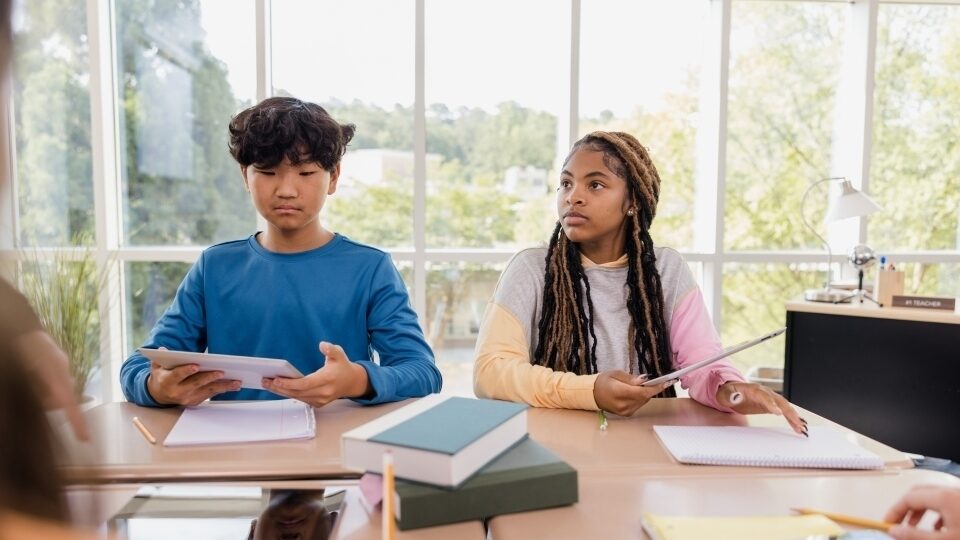
What is small-group intervention?
Intervention in education refers to a set of actions implemented to improve the academic progress of students performing two or more years below grade level. RTI (Response to Intervention) is one framework often used to identify students in need of intervention and to plan and deliver instruction in a systematic way. RTI comprises three tiers:
- Tier 1: General core instruction: Rigorously designed and focused units of instruction, including engaging differentiation for all students.
- Tier 2: Targeted interventions: Allows more time and differentiated supports for students who have not yet mastered the content priorities in a unit.
- Tier 3: Intensive interventions: Recommended for students who require significant intervention relative to their peers in foundational skills, such as reading, writing, numeracy, and behavior, and for students who have not responded to Tier 1 and Tier 2.
Small-group intervention is a method where teachers group students to provide focused support in alignment with an intervention framework. While small-group instruction benefits students in all three tiers, it is especially effective for students in Tier 2. Students in Tier 1 need light support and differentiated instruction to access the general curriculum, and Students in Tier 3 often require intensive, pull-out, and/or individual instruction to meet learning goals. Tier 2 is the sweet spot for small-group instruction strategies because these students can often access the general curriculum with targeted in-class support.
Small-group intervention strategies
With planning, intentional grouping, and thoughtful selection of strategies, small group intervention can be delivered in a classroom setting by the core teacher. We’ll dive into some effective strategies for reading and math instruction, but first let’s look at two core practices necessary to support small group intervention in any classroom:
- Use formative assessment to identify students in need of intervention and as an ongoing tool to provide feedback, adjust instruction, and regroup students. If your school uses the NWEA Map Growth assessment, RIT scores are a valuable tool for accurately placing students in the learning continuum.
- Group students flexibly to optimize the impact of intervention. In many cases, homogenous groups of three to four students are ideal for targeted instruction and teacher feedback. If pairing students with different skills for peer tutoring, heterogenous groups work best. In either case, it is critical to reassess and regroup students in response to their evolving needs.
Small-group reading intervention
In addition to the practices above, here are some useful strategies specific to reading intervention:
Address the core components of literacy instruction. When selecting skills to focus on in small group reading intervention, first ensure they align to the skills on which overall literacy is built: phonemic awareness, phonics, vocabulary, fluency, and comprehension. Then, evaluate skill selection for alignment to students’ developmental needs as identified through formative assessments.
Provide explicit and systematic reading instruction. Explicit instruction begins with clear explanations as well as demonstrations of thinking processes. Thinking aloud is most effective when teachers stop, reflect, and provide an oral explanation of their mental steps. Systematic instruction involves gradual skill building that introduces skills in isolation before integrating them with other skills.
Allow opportunities for practice and feedback. To internalize skills, students need opportunities to practice encoding success. This requires timely and specific corrective feedback. Small groups allow for the level of teacher-student interaction necessary to ensure understanding and mastery.
Small-group math intervention
The concepts underpinning reading intervention strategies—thinking aloud, gradual skill building, practice, and feedback—are key for math intervention as well. Here are some additional, math-specific strategies to support small group intervention:
Guide collaborative problem solving. To attain mathematical proficiency, students need to learn problem-solving strategies to effectively apply their knowledge to solve increasingly complex problems (Swanson, 2013). Providing a consistent framework for students to work together to solve challenging problems helps students practice and develop critical thinking skills.
Make abstract concepts concrete. To support students with the abstract nature of mathematical learning, begin with manipulatives, such as counters or blocks. Then move to visual representations, such as diagrams or graphs. Finally, guide students to connect the models to abstract representations using numbers and symbols.
Small-group intervention lesson plan template
Download this template for guidance planning your own small group intervention lesson:

When students haven’t mastered the content of a unit, thoughtfully implemented small group intervention strategies can often give them the support they need to access the general curriculum. Because so many aspects of learning are cumulative—with new skills building on previous skills—it’s essential to ensure students maintain a strong foundation of understanding to continue building upon.
When implemented with formative assessment data, flexible grouping, and effective strategies, small group intervention can shore up skill gaps as they arise and keep students on the path to success.
***
Explore Read 180, our personalized, adaptive, and student-owned approach to reading intervention for Grades 3–12.
Looking to unlock mathematical learning in the students who need it most? Try Math 180, our revolutionary approach to math intervention for students in Grades 3–12.
Get the guide "Beyond Intervention: How to Make Proficiency Stick for Every Learner."














